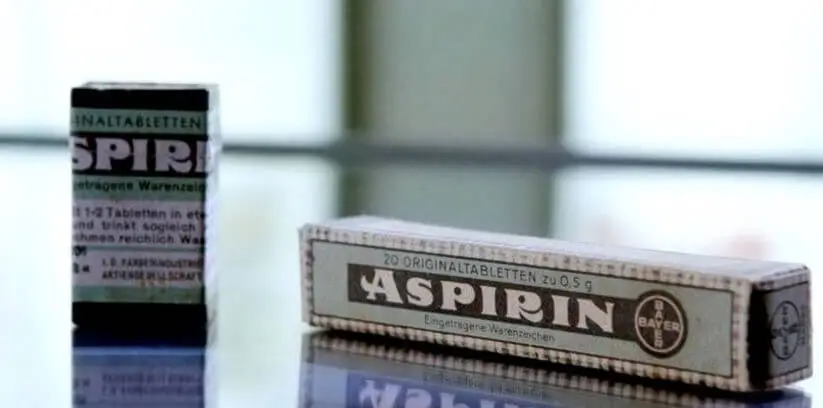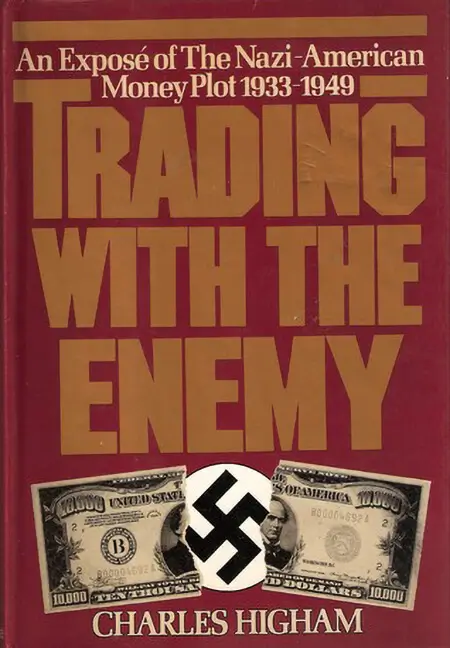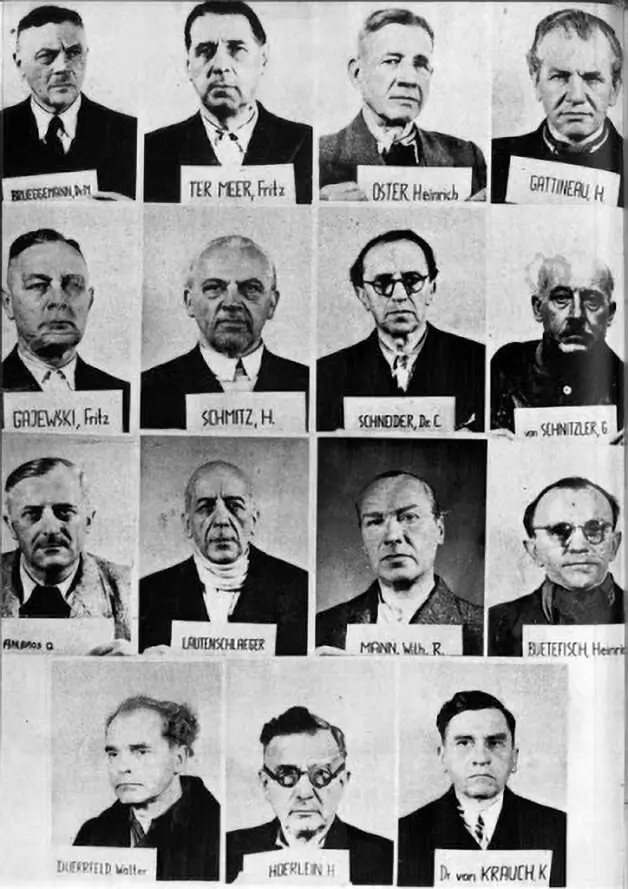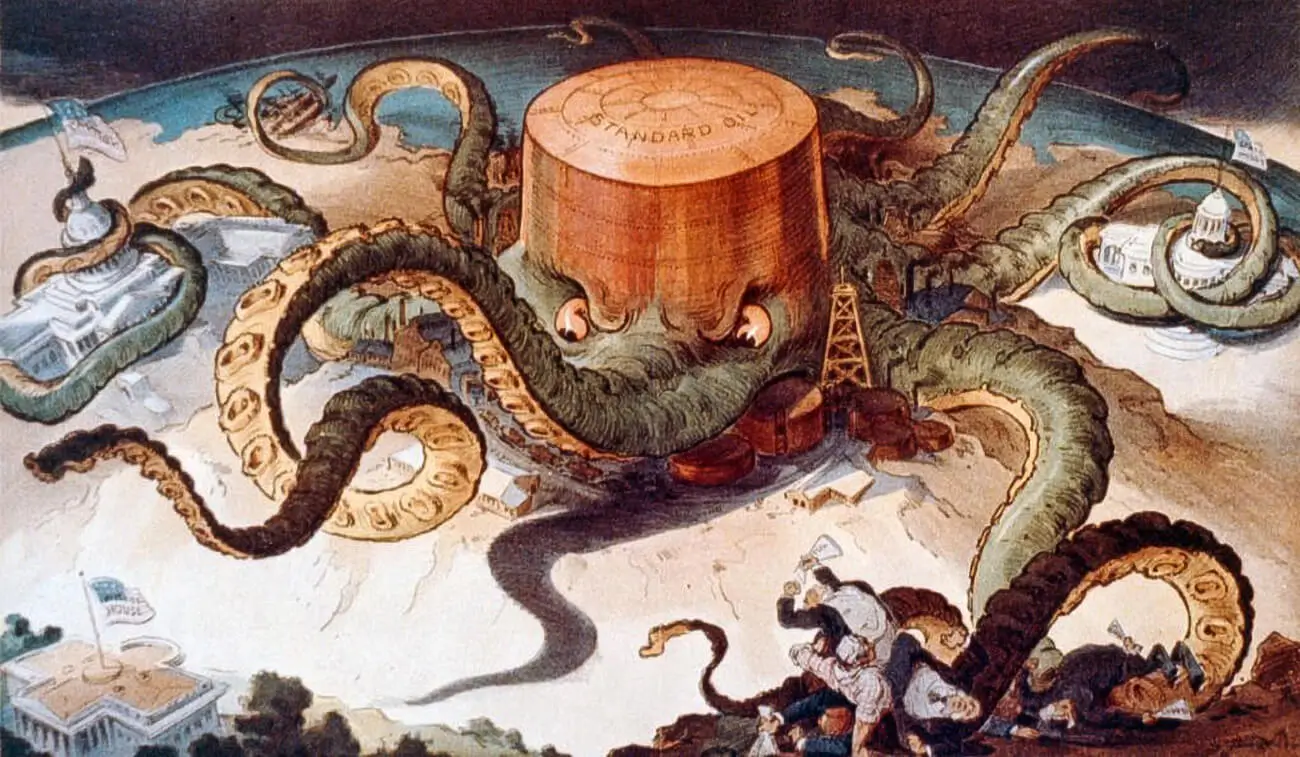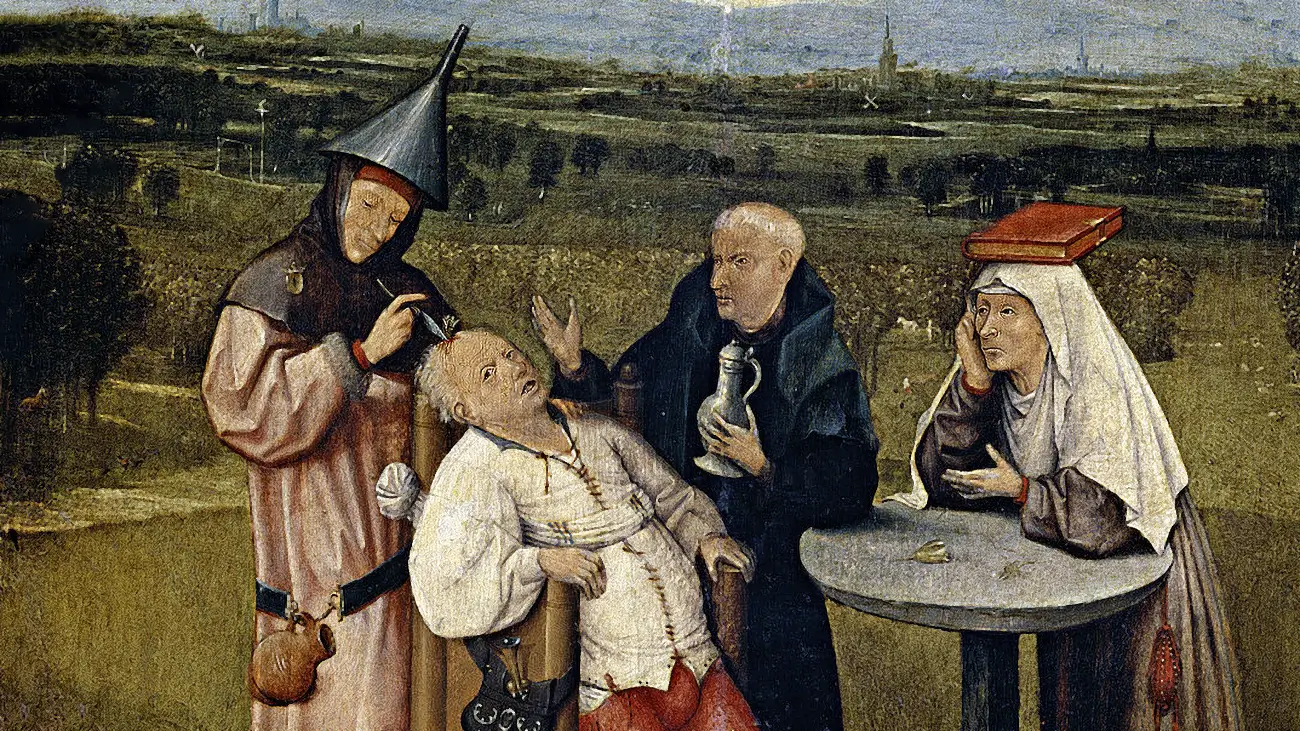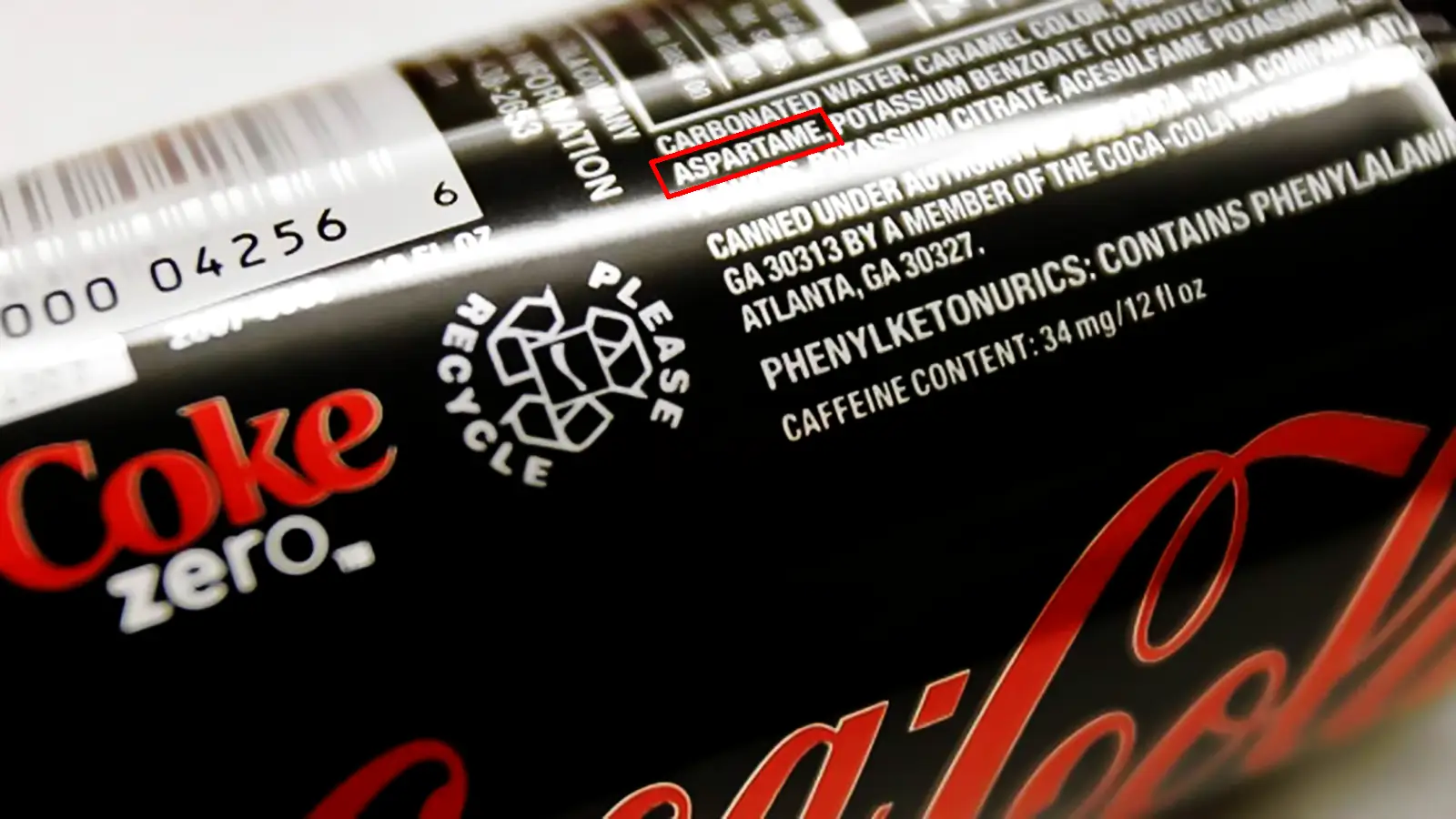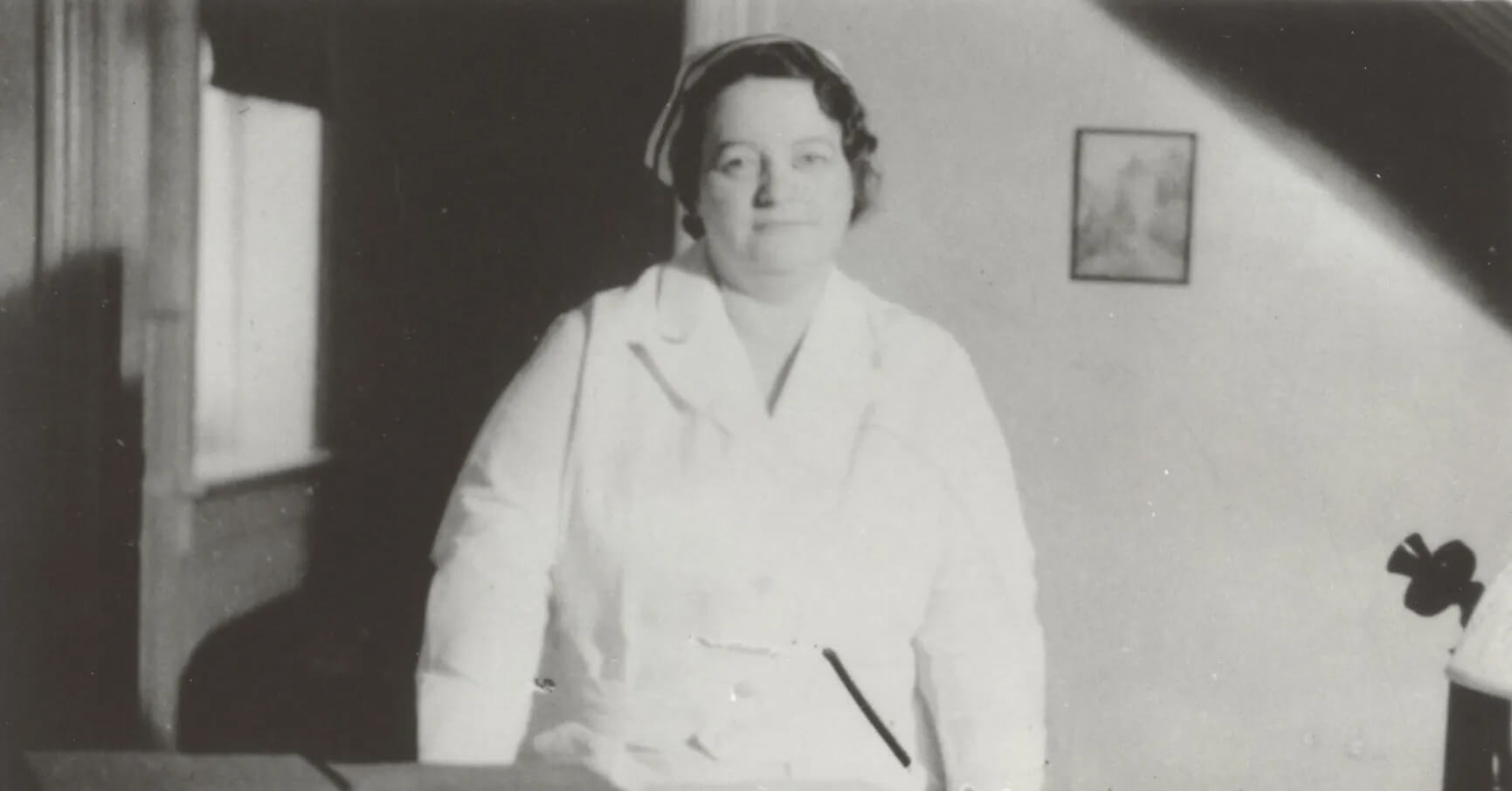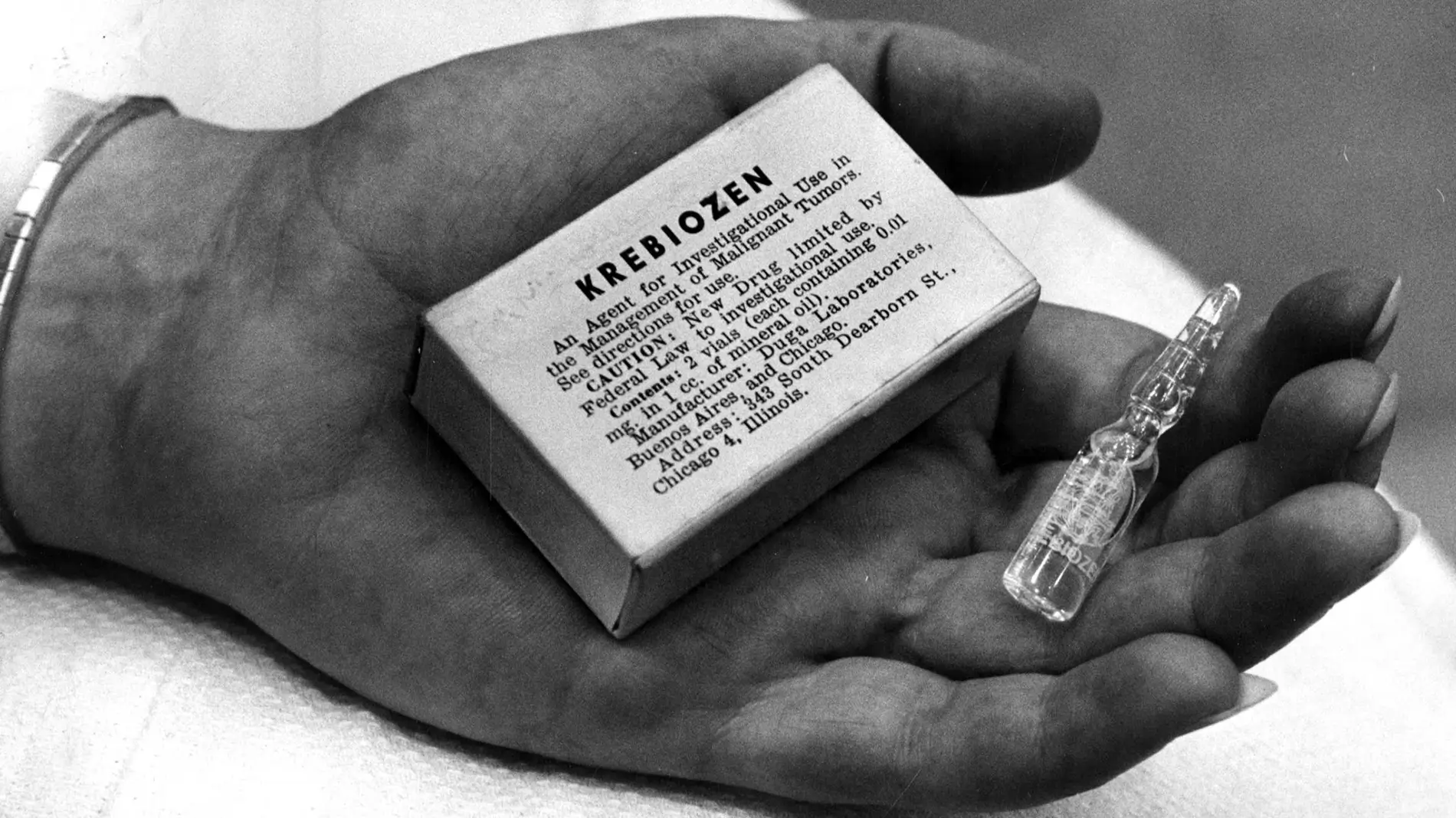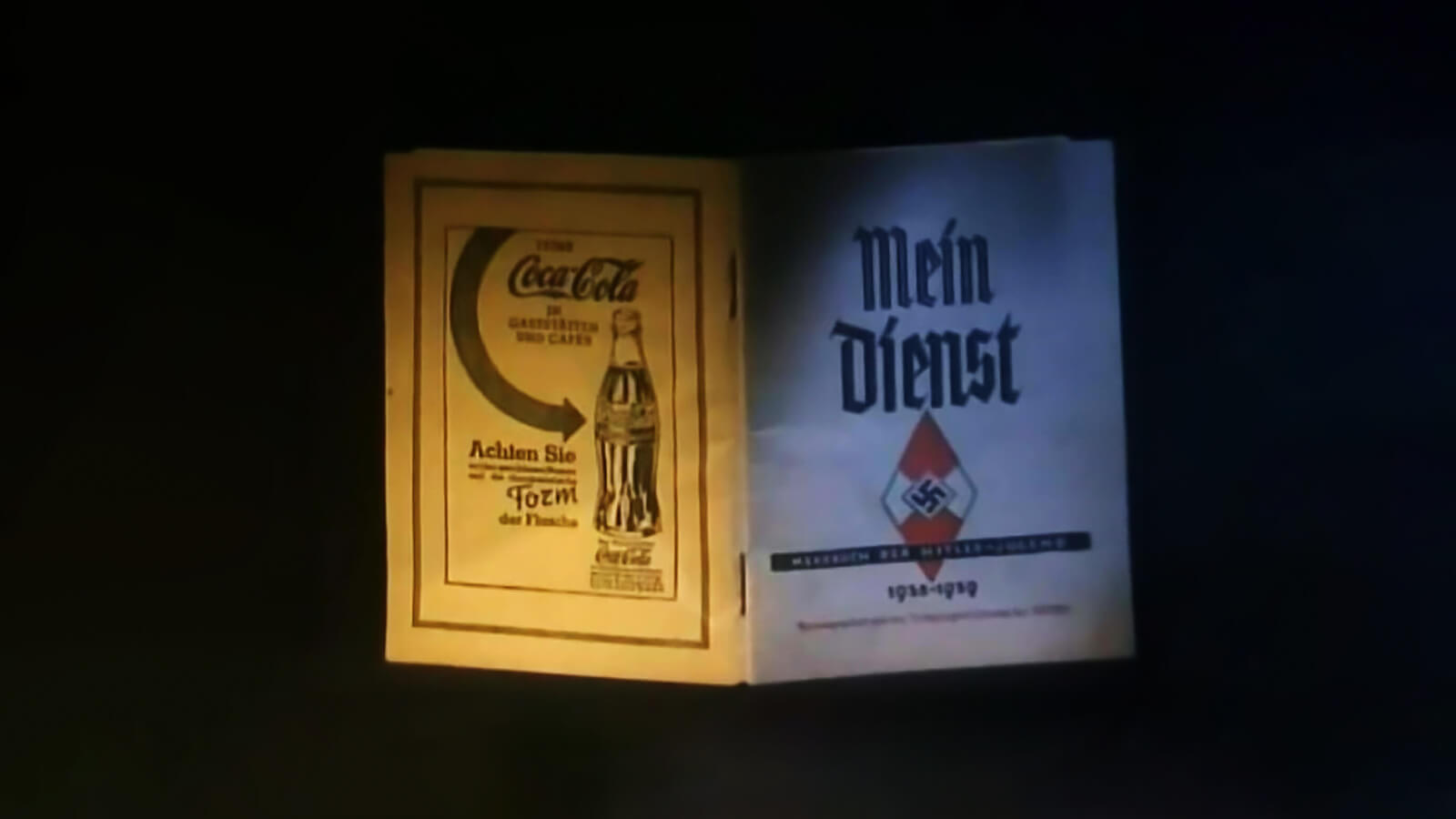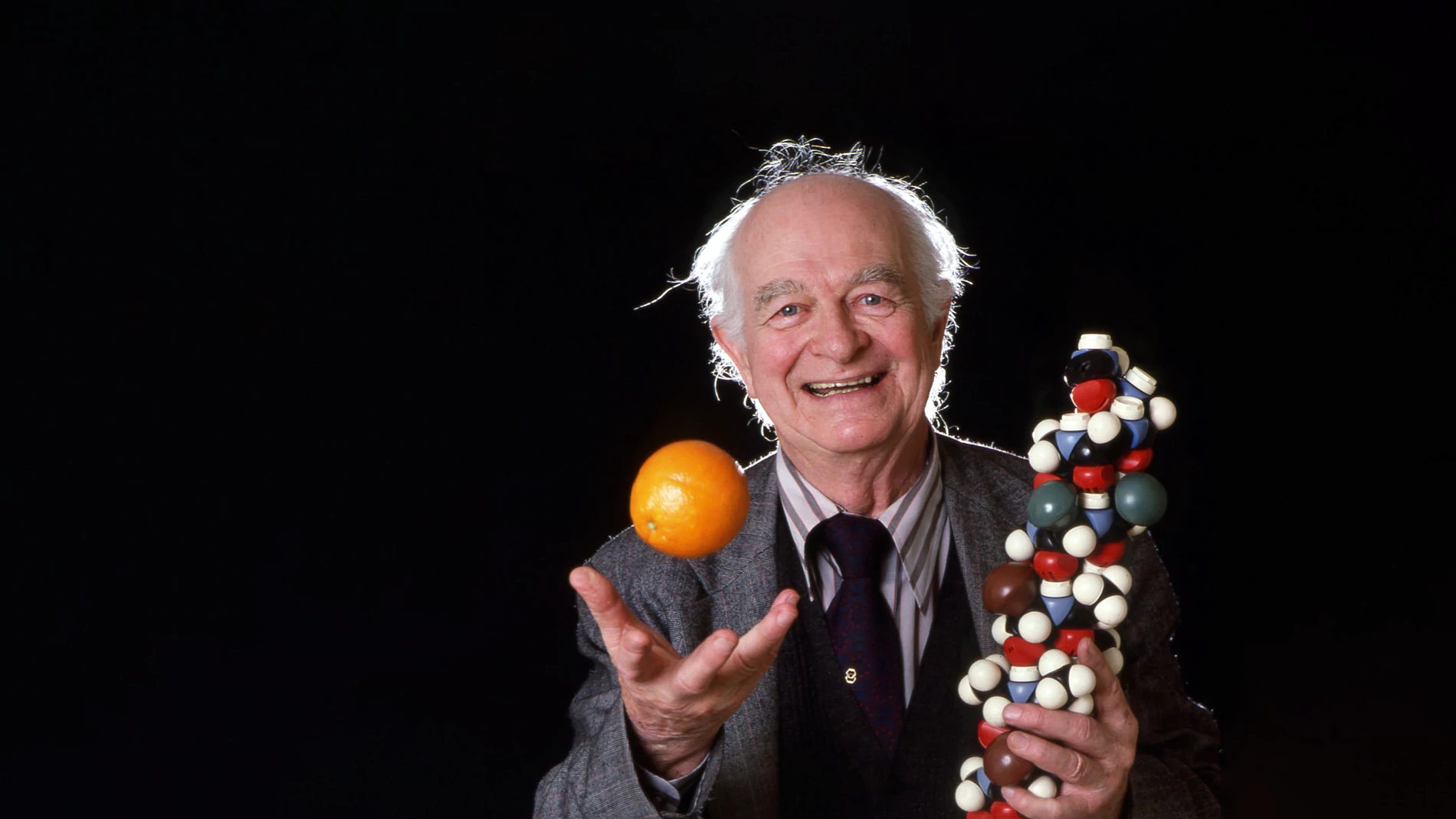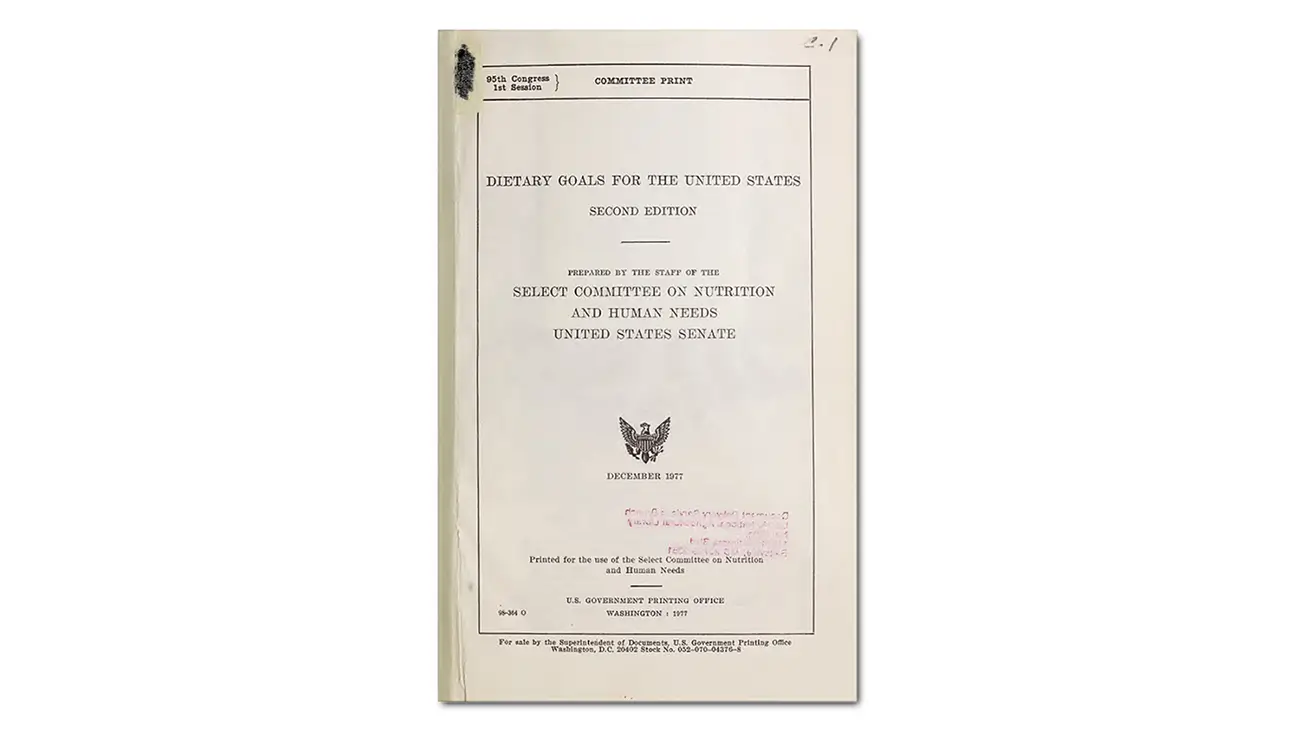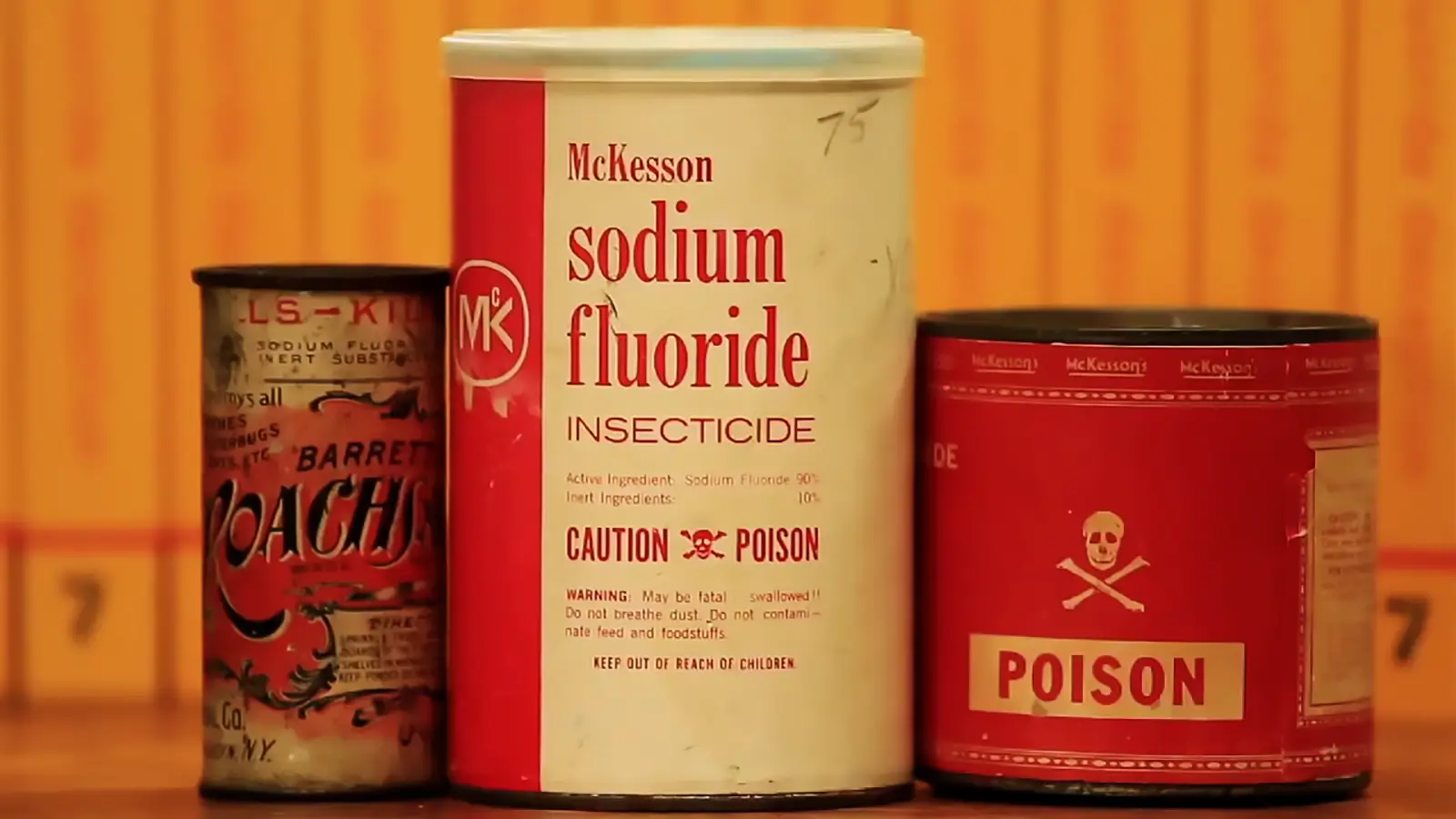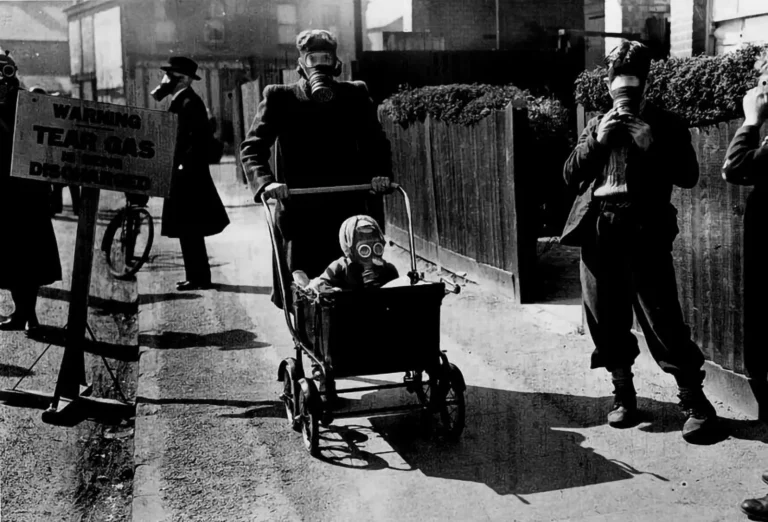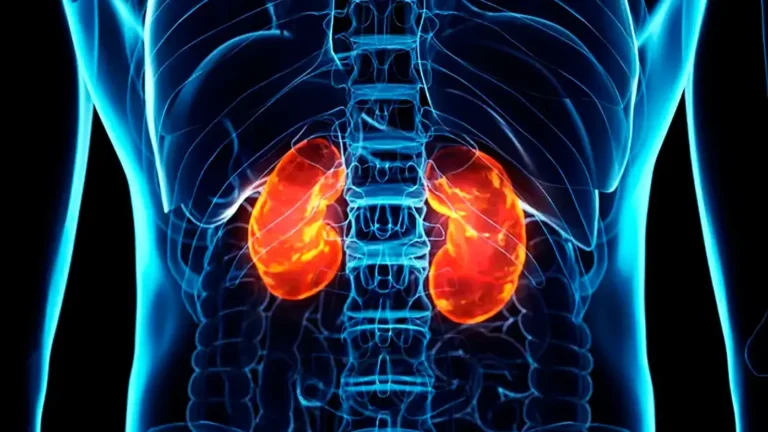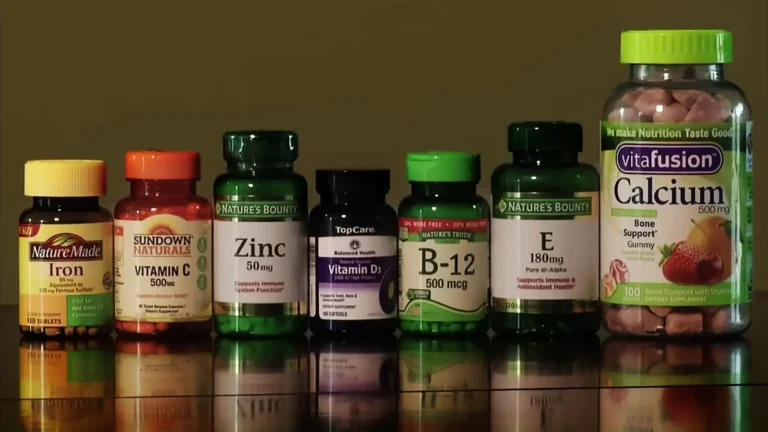La historia de Big Pharma - IG Farben
La parte de Rockefeller monopolio de la química y de la medicina de las industrias de vino en cumplimiento después de la 2 ª guerra mundial. La Standard Oil y la IG Farben cooperación con esta realidad.
Milos Pokimica
Escrito por: Milos Pokimica
Revisado Médicamente Por: Dr. Xiùying Wáng, M.D.
Actualizado el 7 de mayo de 2023"La libertad de una democracia no está a salvo si el pueblo tolera el crecimiento del poder privado hasta un punto en el que llega a ser más fuerte que su propio Estado democrático. Eso, en su esencia, es fascismo: la propiedad del gobierno por un individuo, por un grupo o por cualquier poder privado controlador."
-Presidente Franklin D. Roosevelt
La parte del monopolio de Rockefeller en las industrias quimica y medica se cumplio despues de la segunda guerra mundial. Y esto es a escala mundial, no solo en los Estados Unidos. La cooperacion de Rockefeller y Rothschild hizo esto realidad.
Al otro lado del Atlántico, el cártel internacional de la droga y los productos químicos, IG Farben, llamado "un estado dentro de un estado" fue creado en 1925 como Interessen Gemeinschaft Farbenindustrie Aktien Gesellschaft, normalmente conocido como IG Farben, que simplemente significaba "El Cártel". IG Farben tuvo el monopolio absoluto en la fabricación de todos los productos químicos hasta la Segunda Guerra Mundial. Fueron uno de los financiadores cruciales del rearme de Alemania, si no el que más, con un interés especial en la producción de petróleo para el nuevo ejército mecanizado de Alemania.
Había comenzado en 1904, cuando las seis principales empresas químicas de Alemania iniciaron acuerdos para formar un cártel final, fusionando Badische Anilin, Bayer, Agfa, Hoechst, Weiler-ter-Meer y Griesheim-Electron. La financiación principal procedía de los Rothschild, que seguían representados por su banquero alemán, Max Warburg, de M.M. Warburg Company, Hamburgo.. Más tarde dirigió el servicio secreto alemán durante la Primera Guerra Mundial y fue asesor económico privado del Kaiser. Mientras tanto, el Kaiser fue derrocado, tras perder la guerra, pero Max Warburg no se exilió con él, estaba por encima de la política como agente de un poder superior, por lo que nunca fue a Holanda. En su lugar, se convirtió en asesor económico del nuevo gobierno. También representó a Alemania en la Conferencia de Paz de París. Max Warburg pasó momentos de relax reconstruyendo los lazos familiares con su hermano, Paul Warburg, quien, tras reclutar la Ley de la Reserva Federal en Jekyll Island, controlaba el sistema bancario estadounidense durante la guerra. También estuvo presente en París como asesor financiero de Woodrow Wilson.
Dos hermanos controlaban dos sistemas bancarios diferentes en países supuestamente en guerra entre sí. Antes de la Segunda Guerra Mundial, Max Warburg formaba parte del consejo de administración de IG Farben. Su hermano Paul Warburg formaba parte del consejo de administración de I.G. Farben, concretamente de una filial estadounidense. La familia Warburg era una prominente familia bancaria alemana y estadounidense de ascendencia judía alemana y originalmente judía veneciana, momento en el que llevaron el apellido del-Banco. Sin embargo, en un momento dado, el banco Warburg de Hamburgo estaba a punto de colapsar en 1857, y los Rothschild inyectaron grandes cantidades de dinero en él convirtiéndose en el nuevo propietario del banco. Desde este periodo en adelante el banco M.M. Warburg y sus socios operaron efectivamente como testaferros de los Rothschild. El primer socio conocido que utilizó el nombre "Rothschild" fue Izaak Elchanan Rothschild, nacido en 1577. El nombre Rothschild en yiddish significa Abrigo Rojo. I.G. Farben se convirtió rápidamente en una empresa con un patrimonio neto de seis mil millones de marcos, que controlaba más de quinientas empresas.
Mientras la República de Weimar empezaba a derrumbarse, los funcionarios de IG, viendo las cosas claras, iniciaron una estrecha colaboración con Adolf Hitler, proporcionándole las enormes cantidades de fondos e influencia política que necesitaba. El progreso del cártel de I.G. Farben había despertado interés y se extendió también a otros industriales. Henry Ford quedó bastante impresionado y creó una sucursal alemana de la Ford Motor Company. IG Farben compró el cuarenta por ciento de las acciones. A continuación, I.G. Farben creó una filial americana, llamada American I.G., en cooperación con Standard Oil de Nueva Jersey. En 1930, Standard Oil declaró que había adquirido el monopolio del licor en Alemania, un acuerdo que tenía con IG Farben. Ya se estaba extendiendo por Europa industria alimentaria. Despues que el partido Nazi llego al poder, John D. Rockefeller contrato a su propio agente de prensa, Ivy Lee, para que Hitler trabajara como consultor de tiempo completo en el rearme de Alemania. Ellos ya habian decidido rearmar Alemania y tener la Segunda Guerra Mundial asi que ya en ese entonces los pasos necesarios para preparar la Segunda Guerra Mundial habian comenzado. Standard Oil construyó grandes refinerías en Alemania para los nazis y continuó suministrándoles petróleo durante la Segunda Guerra Mundial. En 1939 Frank Howard, un vicepresidente de Standard Oil visitó Alemania e hizo algunos arreglos. Más tarde testificó:
"Hicimos todo lo posible por elaborar planes completos para un modus vivendi que funcionara durante todo el tiempo que durara la guerra, tanto si entrábamos como si no. "
Aunque su nombre apenas se conoce, Frank Atherton Howard era en aquella época uno de los principales agentes que dirigían las operaciones de Standard Oil. También fue director del comité de investigación del Sloan Kettering Institute durante la década de 1930. Era un agente de los Rockefeller y era bueno en su trabajo. Su designado en el Sloan Kettering, Dusty Rhoads, dirigió la investigación que creó la quimioterapia. Durante la Segunda Guerra Mundial, Rhoads dirigió el Servicio de Guerra Química en Washington, en el cuartel general del ejército estadounidense. Los mismos hombres investigaron una cura para el cáncer y productos químicos para la matanza de personas en las guerras, lo que ya suena familiar a estas alturas. Hombres que trabajan para el sindicato Rockefeller. Fue Frank Howard quien influyó en Alfred Sloan y Charles Kettering de General Motors en 1939 para que hicieran grandes donaciones al Centro del Cáncer, que luego tomó sus nombres. La segunda esposa de Frank Howard era un miembro destacado de la aristocracia británica, la duquesa de Leeds. Escribo su estado civil sólo para que entendamos quién es en realidad el gobierno, la aristocracia, la democracia, el capitalismo, etcétera. Todo es lo mismo. Frank Howard fue el ejecutivo clave en la gestión de las relaciones entre Standard Oil e IG Farben trabajando para coordinar los intereses de ambas compañías. Dirigió la investigación en el avance del caucho artificial, que fue vital para Alemania en la Segunda Guerra Mundial. Más tarde incluso escribió un libro, "Buna Rubber". Además, IG Farben apoyó directamente y sin tapujos al Partido Nazi.
En una conferencia de industriales alemanes con nazis como Hermann Goering y Heinrich Himmler, celebrada el 20 de febrero de 1933, IGF aportó 400.000 reichsmarks al Partido Nazi. Fue la mayor cantidad del total de 3 millones de reichsmarks recaudados en esta reunión por los industriales alemanes para la campaña electoral del Partido Nazi. IG Farben contribuyó cuatro millones y medio de reichsmarks al Partido Nazi en 1933; en 1945, I.G. había proporcionado al Partido 40 millones de reichsmarks, una suma que igualó todas las donaciones de I.G. a todos los otros beneficiarios durante ese período. Ahora permítanme hacer esta pregunta. ¿Piensan ustedes que los gobiernos americanos o ingleses no sabian lo que estaba pasando y de donde venia el dinero? Ellos planearon y financiaron la WW2 entera por diseño. Por ejemplo, sin la clara ayuda de Standard Oil, las fuerzas aéreas nazis nunca habrían podido volar. Los aviones que componían la Luftwaffe necesitaban gasolina de tetraetilo de plomo para poder volar. En aquella época, sólo General Motors, Standard Oil y Du Pont tenían la capacidad de producir esta sustancia vital. Todas empresas fuera de Alemania. En 1938, Walter C. Teagle, director de Standard Oil, consiguió que Hermann Schmitz, de I.G. Farben, obtuviera 500 toneladas de tetraetilo de plomo de Ethyl, una filial británica de Standard Oil. Un año más tarde, Schmitz regresó a Londres y compró tetraetilo de plomo por valor de 15 millones de dólares más. De vuelta en Alemania, lo convirtió en gasolina de aviación para la Luftwaffe.
Fue en 1927 cuando Standard Oil e IG Farben fundaron la empresa "Standard IG Farben". Standard cedió a IG Farben las patentes sobre los procesos de hidrogenación del carbón y los alemanes les dieron las patentes sobre cómo fabricar caucho sintético. Mientras que las potencias europeas querían evitar el crecimiento de la industria alemana tras la Primera Guerra Mundial, Estados Unidos gastó enormes sumas de dinero en la reconstrucción de Alemania y nunca ratificó el Tratado de Versalles. En realidad, no el gobierno de EE.UU., sino el verdadero poder del Estado profundo detrás de él. Incluso vendieron bonos alemanes en el mercado financiero estadounidense. Una de las más importantes fue la "Union Banking Corporation" de George H. Walker. Nombró director de la firma a su yerno, Prescott Bush, abuelo del presidente estadounidense George W. Bush.
Su nieto el presidente americano de la época George W. Bush estaba en la actualización 3.0 dándole la mano al primer ministro israelí y hablando de la unidad de los pueblos americano e israelí en la "guerra del terror" olvidando el hecho de que su abuelo Prescott utilizaba mano de obra esclava judía en su planta de fabricación de acero en Auschwitz..
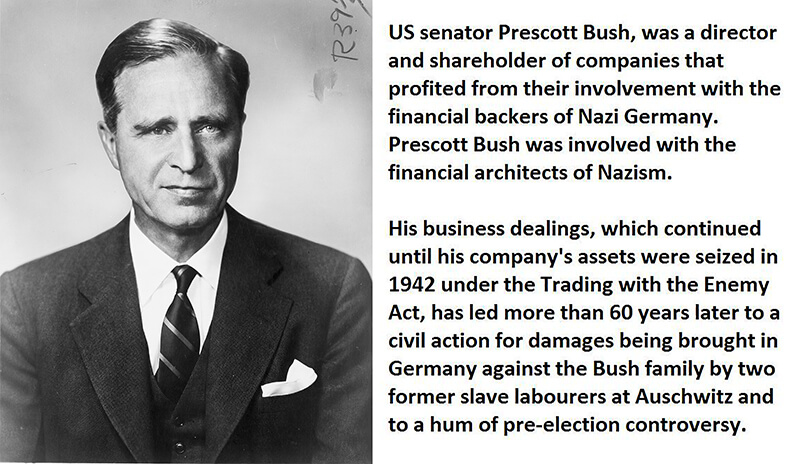
En la actualización 1.0 el padre de Prescott, Samuel P. Bush, presidente durante mucho tiempo de la empresa Buckeye Steel Castings que era propiedad de Frank Rockefeller, el hermano de John D. Rockefeller, suministraba piezas para los ferrocarriles de Edward Henry Harriman que a su vez proporcionaba envíos por ferrocarril para la Standard Oil de John que a su vez obtiene financiación monopolística de los Rothschild. El hijo de Samuel, Prescott, era el director gerente de una fábrica de acero nazi en Polonia llamada Celestion Consolidated Steel que en la actualización 2.0 remitió financiación americana a su socio alemán Fritz Thyssen a través de "Union Banking Corporation" en Nueva York. Fritz Thyssen arregla un contrato con IG Farben para obtener mano de obra esclava judía gratuita en la planta de fabricación de acero de Bush en el campo de concentración de Auschwitz.
En la actualización 2, Prescott Busch y Averell Harriman (hijo del barón del ferrocarril E. H. Harriman, 48º gobernador de Nueva York y uno de los principales miembros del grupo de expertos en política exterior conocido como "Los Sabios" y miembro de Skull and Bones) se ven atrapados por la ley de comercio con el enemigo cuando el gobierno estadounidense interviene y confisca todas las acciones de Union Banking Corporation.
En la actualización 4.0 el hijo de Prescott primero George Bush es el director de la CIA. George empuja rey de la droga Manuel Noriega en la nómina de la CIA y permitió toneladas de cocaína a golpear las calles de América a través del Canal de Panamá.
En la actualización 5.0 el hijo de George, el segundo George Bush, se asocia con el hermano mayor de Osama bin Laden, Salem bin Laden, en una empresa petrolera de Texas llamada Arbusto energy. También en la actualización 5, tenemos una introducción al turbio hermano menor de George, Neil Bush, estafando a los ancianos en el escándalo de Silverado Saving and Loan, que costó a los contribuyentes estadounidenses 1.300 millones de dólares.
En la actualización final 6.0, tenemos a George W. Bush, el presidente estadounidense, visitando un campo de exterminio en Auschwitz para dar un discurso sobre "resistir el poder del mal", donde su abuelo ayudó a construir la fortuna de la familia Bush con mano de obra esclava judía gratuita. George Herbert Walker abuelo materno del Presidente George H. W. también consiguió grandes contratos con los alemanes, antes y después de 1933. En el consejo de su "Walkers American Shipping and Commerce Company" con su Hamburg-America Line estaba Emil Helfferich, miembro de "Freundeskreis Reichsführer- SS" y hasta el final de la Segunda Guerra Mundial Presidente de Deutsch-Amerikanische Petroleum Gesellschaft, más tarde ESSO, y Vacuum Oil Company en Hamburgo.
El principal problema para el ataque de Alemania a la Unión Soviética era la necesidad de combustible para tanques y aviones. Gracias a las patentes de la Standard Oil, los alemanes podían producir combustible a partir de su propio carbón, pero no era suficiente. Una vez iniciada la batalla en Europa, los ingleses se molestaron por los envíos estadounidenses de materiales vitales a la Alemania nazi. Standard Oil transfirió instantáneamente el registro de toda su flota a Panamá para evitar el registro o embargo británico. Estos barcos se trasladaron para llevar petróleo a Tenerife, donde repostaron a los petroleros alemanes para su envío a Hamburgo. Este engaño quedó al descubierto el 31 de marzo de 1941, cuando el Departamento de Estado de Estados Unidos publicó un informe completo sobre las terminales de repostaje en México y América Central y del Sur. ¿Qué ocurrió entonces? No ocurrió nada. No hay ningún informe de que se tomara ninguna forma de acción porque todo esto estaba planeado a un nivel más alto que sólo el gobierno de Estados Unidos.
Una breve nota al margen, sin embargo, es que el 17 de abril de 1945, el Chase National Bank fue juzgado en un tribunal federal acusado de haber infringido la Ley de Comercio con el Enemigo al cambiar marcos alemanes por dólares estadounidenses. Debido a que múltiples naciones rechazaron la moneda alemana a lo largo de la guerra, los nazis utilizaron bancos internacionales como el Chase National de los Rockefeller para cambiar la moneda en dinero que sería aceptado como dólares, y esto les permitiría comprar más materiales muy necesarios para prolongar la guerra.
En el sentido de las contundentes opiniones del propio Adolf Hitler sobre el control judío en Alemania, sería todo un reto explicar el papel de I.G. Farben en la época nazi. ¿Por qué? Porque I.G. Farben estaba controlada en su mayor parte por banqueros judíos, es decir, por los Rothschild en particular. Durante los años 20 fue acusada por los nazis de ser una "empresa judía capitalista internacional".
El exhaustivo estudio de Peter Hayes sobre I.G. Farben señala que en 1933 contaba con diez judíos en sus consejos de administración y no hay que olvidar que se formó gracias a la financiación de Rothschild. La misma empresa que había comprado la patente del pesticida Zyklon B en los años veinte y que más tarde lo distribuyó en las cámaras de gas de Auschwitz. Además de una planta de aceite sintético y caucho en Auschwitz, la empresa también realizaba experimentos con drogas en reclusos vivos. Este aparato utilizaba tanta electricidad como toda la ciudad de Berlín, y más de 25.000 internos del campo murieron durante su construcción. I.G. Farben acabó construyendo su propio campo de concentración, conocido como Monowitz, que estaba más cerca de la fábrica para reducir la necesidad de trasladar varios kilómetros a prisioneros ya famélicos al borde de la muerte, lo que disminuía la eficacia de su trabajo. La misma empresa que nos da aspirinas.
En la foto de abajo, se puede ver el campo de concentración construido para la I.G. Farben Monowitz, y debajo del campo la sede de la I.G. Farben intacta por la guerra y las bombas americanas (no por accidente).
El libro de Hingham, "Trading with the Enemy", ofrece amplia documentación sobre las actividades de los Rockefeller durante la Segunda Guerra Mundial.
Mientras los aviones de Hitler arrojaban toneladas de bombas sobre Londres, ellos gastaban el dinero de los royalties de la gasolina que quemaban a la Standard Oilen virtud de los acuerdos sobre patentes vigentes. Después de la guerra, la reina Isabel visitó EE.UU. Sólo se alojó en una casa privada durante su visita, la finca en Kentucky de William Irish, de Standard Oil.. Tras la increíble destrucción de la mayoría de las ciudades alemanas por los bombardeos aéreos de la Segunda Guerra Mundial, los edificios de I.G. permanecieron intactos por algún milagro. El "desmantelamiento" de IG Farben de 1945 a 1952 por el Gobierno Militar Aliado, fue un proceso similar al "desmantelamiento" del imperio Standard Oil por edicto judicial en 1911. Las tres grandes empresas creadas (escisiones de Farben) seguían comportándose como un cártel.
¿A quién pertenecen? ¿A quién pertenece Bayer, por ejemplo?
La respuesta es el cártel bancario internacional. En 1939, mientras se hacía evidente que Alemania pronto sería impopular en Estados Unidos, Standard Oil ayudó a I.G. Farben a cubrir sus participaciones americanas en el campo farmacéutico y químico. Se constituyó el American IG, que transfirió gran parte de las finanzas al mercado estadounidense mediante la compra de las empresas Winthrop Chemical, Grasseli Chemical Works (alias General Aniline Works), Agfa-Film Company, Sterling Products Company y Magnesium Development. Standard Oil recibió 15% de las acciones del nuevo trust químico germano-americano. Los esfuerzos para enganchar a la corporación DuPont en esta fusión fracasaron parcialmente. Entre los directores de la empresa "tapadera" se encontraban Walter Teagle (presidente de la Standard Oil Company), Paul Warburg (agente de Rothschild) y Edsel Ford. El consejo de administración de American I.G. contaba con tres directivos del Banco de la Reserva Federal de Nueva York. American I.G. también tenía vínculos con el Bank of Manhattan (que más tarde se convertiría en el Chase Manhattan), Ford Motor Company, Standard Oil of New Jersey y A.E.G. (German General Electric). Tres miembros alemanes no estadounidenses del consejo de esta A.E.G. fueron declarados culpables en los Juicios por Crímenes de Guerra de Nuremberg. Entre estos alemanes estaba Max Ilgner, director de las oficinas de I.G. Farben N.W. Seven en Berlín, es decir, la oficina de inteligencia nazi antes de la guerra. Con Pearl Harbor y la entrada de Estados Unidos en la Segunda Guerra Mundial, la IG Farben estadounidense optó por ocultar su origen alemán y sus alianzas, con la ayuda de la Standard Oil. Convirtió su nombre en General Aniline & Film Corporation poco antes del ataque a Pearl Harbor. Antes de hacerlo, American IG compró un número no revelado de acciones de Monsanto Chemical, Drug Incorporated, Mission Corporation, Dow Chemical, Schering & Company, Ozalid Corporation, Antidolar Company, Aluminum Corporation, Standard Oil of California, Standard Oil of Indiana, Standard Oil of New Jersey y DuPont Company. También adquirió la Hoffman-LaRoche Company. Bajo el régimen nazi, la rama alemana de la corporación química Standard Oil era simplemente una sola empresa. Se fusionó con cientos de acuerdos de cárteles.
I.G. Farben fue dirigida, hasta 1937, por la familia Warburg. El agente de Rockefeller en la banca que ayudó a diseñar la eugenesia de la Alemania nazi y que en realidad era de nuevo sólo un agente del sindicato Rothschild. Despues del ataque aleman a Polonia en 1939, Standard Oil prometio mantener la fusion con I.G. Farben aun si los Estados Unidos se unian a la guerra. La fusion fue probablemente planeada por el cartel bancario londinense de los Rothschild antes de la guerra. Rockefeller hasta cierto punto estaba representando el interes de la familia Rothschild al otro lado del Atlantico pero subyacente es la misma fuerza controladora que financio todo esto. Cuando los soldados americanos entraron en la ciudad manufacturera de Frankfort, se quedaron asombrados al descubrir los edificios en perfecto estado y la enorme planta de la empresa alemana IG Farben Chemical Trust intacta. Los aviadores estadounidenses demolieron por completo todas las demás estructuras de la ciudad. La fábrica de Farben en Frankfort, una de las mayores construcciones del lugar, milagrosamente permaneció intacta. No fue casualidad que el gobierno de posguerra de Alemania, el Gobierno Militar Aliado, también estableciera sus oficinas en el edificio de I.G. Farben. Esta administración estaba dirigida por el general Lucius Clay, que más tarde se convertiría en socio de Lehman Brothers. Lo que los donjuanes tampoco sabían era que el Secretario de Guerra, Robert P. Patterson, era un abogado de los Rockefeller. Fue nombrado por el presidente Roosevelt recién salido de Dillon, Read, and Company. La empresa Dillon-Read no sólo es una filial de Rockefeller sino que fue la casa bancaria que financió a la IG Farben alemana y se ocupó de los detalles comerciales de la formación de la empresa estadounidense "encubridora" del cártel químico alemán.
En medicina, el cártel Rockefeller sigue protegiendo su Monopolio Médico. Su control de la industria del cáncer pasa por el Sloan Kettering Cancer Center. Todas las grandes empresas farmacéuticas están financiadas, cada una por su ejecutivo del Chase Manhattan Bank, la Standard Oil Company u otras empresas de los Rockefeller. El Colegio Americano de Cirujanos mantiene el control de los hospitales a través del poderoso Comité de Encuestas Hospitalarias, con miembros nombrados por y para representar el control de Rockefeller. Al otro lado del Atlántico ocurría lo mismo.
BASF SE (Alemania) - ¡La mayor empresa química de todo el mundo! En 2020 facturó 60.000 millones de euros.
Bayer I.G. (Alemania) - Una de las mayores empresas farmacéuticas del mundo. Comenzó como una empresa de tintes y se consolidó en IG Farben en 1881.
Hoechst AG (Alemania) - uno de los mayores fabricantes farmacéuticos del mundo, ahora Sanofi-Aventis;
Sanofi-Aventis - (Francia), creada por una fusión en 2004 entre Aventis (fusión en 1999 de Rhone-Poulenc y Hoechst AG (IG Farben)) y Sanofi;
Wyeth - (EE.UU.) En 2002 pasó a llamarse Sterling Drug Inc. (filial estadounidense de IG Farben) y luego se fusionó con Pfizer en 2009.
Pfizer - (EE.UU.), fundada en 1849 en Nueva York. Compró Warner-Lambert, Parke-Davis, Upjohn, Pharmacia (Monsanto) y Wyeth (filial estadounidense de IG Farben).
Agfa-Gevaert N.V. (Agfa) suministra a hospitales y otras organizaciones sanitarias productos y sistemas de tratamiento de imágenes, así como sistemas de información y sistemas industriales de inyección de tinta a las industrias gráfica y de impresión. El comercio actual de Agfa-Gevaert es 100% business-to-business.
Referencias:
Pasajes seleccionados de un libro: Pokimica, Milos. Go Vegan? Examen de Ciencias de la Parte 2. Kindle ed., Amazon, 2018.
Contenidos Relacionados
¿Tienes alguna duda acerca de la nutrición y la salud?
Me encantaría saber de usted y responderlas en mi próxima publicación. Agradezco sus aportes y opiniones y espero tener noticias suyas pronto. También te invito a síguenos en Facebook, Instagram y Pinterest para más contenidos sobre dieta, nutrición y salud. Puedes dejar un comentario allí y conectar con otros entusiastas de la salud, compartir tus consejos y experiencias, y recibir apoyo y ánimo de nuestro equipo y nuestra comunidad.
Espero que este post le haya resultado informativo y ameno y que esté preparado para aplicar los conocimientos adquiridos. Si le ha resultado útil, por favor compártelo con tus amigos y familiares que también podrían beneficiarse de ella. Nunca se sabe quién puede necesitar orientación y apoyo en su camino hacia la salud.
– También Te Puede Interesar –

Aprenda Sobre Nutricion
Milos Pokimica es doctor en medicina natural, nutricionista clínico, escritor sobre salud médica y nutrición y asesor en ciencias de la nutrición. Autor de la serie de libros Go Vegan? Revisión de la Ciencia, también dirige el sitio web sobre salud natural GoVeganWay.com.
Descargo De Responsabilidad Médica
GoVeganWay.com le ofrece reseñas de las últimas investigaciones relacionadas con la nutrición y la salud. La información proporcionada representa la opinión personal del autor y no pretende ni implica sustituir el asesoramiento, diagnóstico o tratamiento médico profesional. La información proporcionada tiene fines informativos únicamente y no pretende sustituir la consulta, el diagnóstico y/o el tratamiento médico de un médico o proveedor de atención médica calificado.NUNCA ignore el CONSEJO MÉDICO PROFESIONAL O RETRASAR la BÚSQUEDA de TRATAMIENTO MÉDICO a CAUSA DE ALGO QUE HAYA LEÍDO EN O accesibles a TRAVÉS de GoVeganWay.com
NUNCA APLICAR CUALQUIER cambio de ESTILO de vida O CAMBIOS EN su totalidad COMO UNA CONSECUENCIA DE ALGO QUE HA LEÍDO EN GoVeganWay.com ANTES de CONSULTAR con LICENCIA PROFESIONAL MÉDICO.
En el caso de una emergencia médica, llame a un médico o al 911 inmediatamente. GoVeganWay.com no se recomienda ni aprueba ninguna de los grupos, las organizaciones, las pruebas, los médicos, productos, procedimientos, opiniones u otra información que pueda ser mencionado en el interior.
Selecciones del editor –
Milos Pokimica es escritor especializado en salud y nutrición y asesor en ciencias nutricionales. Autor de la serie de libros Go Vegan? Revisión de la Ciencia, también dirige el sitio web sobre salud natural GoVeganWay.com.
Últimos artículos -
Top Noticias De Salud — ScienceDaily
- Harvard gut discovery could change how we treat obesity and diabetesen diciembre 14, 2025
Scientists found that certain molecules made by gut bacteria travel to the liver and help control how the body uses energy. These molecules change depending on diet, genetics, and shifts in the microbiome. Some even improved insulin response in liver cells when tested in the lab. The findings could open the door to new ways of preventing or managing obesity and diabetes.
- A grad student’s wild idea triggers a major aging breakthroughen diciembre 14, 2025
Senescent “zombie” cells are linked to aging and multiple diseases, but spotting them in living tissue has been notoriously difficult. Researchers at Mayo Clinic have now taken an inventive leap by using aptamers—tiny, shape-shifting DNA molecules—to selectively tag these elusive cells. The project began as an offbeat conversation between two graduate students and quickly evolved into a collaborative, cross-lab effort that uncovered aptamers capable of binding to unique surface proteins […]
- Natural compound supercharges treatment for aggressive leukemiaen diciembre 14, 2025
Forskolin, a plant-derived compound, shows surprising potential against one of the most aggressive forms of leukemia. Researchers discovered that it not only stops cancer cells from growing but also makes them far more vulnerable to chemotherapy by preventing them from pumping out the drugs meant to kill them. Experts say this dual action could help create safer, more powerful AML treatments with fewer harsh side effects.
- AI finds a hidden stress signal inside routine CT scansen diciembre 14, 2025
Researchers used a deep learning AI model to uncover the first imaging-based biomarker of chronic stress by measuring adrenal gland volume on routine CT scans. This new metric, the Adrenal Volume Index, correlates strongly with cortisol levels, allostatic load, perceived stress, and even long-term cardiovascular outcomes, including heart failure risk.
- Tea may strengthen bones in older women while heavy coffee weakens themen diciembre 13, 2025
A decade-long study of older women found that tea drinkers had slightly stronger bones, while moderate coffee drinking caused no harm. Heavy coffee intake—over five cups a day—was linked to lower bone density, especially in women who consumed more alcohol. Tea’s benefits may stem from catechins that support bone formation. The researchers say small daily habits could make a meaningful difference over time.
- The brain switch that could rewrite how we treat mental illnessen diciembre 13, 2025
Scientists exploring how the brain responds to stress discovered molecular changes that can influence behavior long after an experience ends. They also identified natural resilience systems that help protect certain individuals from harm. These findings are opening the door to treatments that focus on building strength, not just correcting problems. The work is also fueling a broader effort to keep science open, independent, and accessible.
- Ozempic may offer a surprising bonus benefit for brain healthen diciembre 13, 2025
A new analysis suggests that people with type 2 diabetes who use GLP-1 medications like Ozempic, Trulicity or Victoza may be less likely to develop epilepsy than those taking DPP-4 inhibitors. Semaglutide showed the strongest connection to lowered risk. Researchers caution that the findings show an association, not proof of cause and effect. More rigorous long-term studies are needed to understand the link.
PubMed, #Dieta vegana –
- Healthful and Unhealthful Plant-Based Diets and Their Association with Cardiometabolic Targets in Women Diagnosed with Breast Cancer: A Cross-Sectional Analysis of a Lifestyle Trialen diciembre 11, 2025
CONCLUSIONS: Maintaining cardiometabolic risk factors within normal ranges is clinically relevant in BCS, and this may be more likely when a plant-based diet is consumed, especially if low in unhealthy plant foods.
- Dietary and Lifestyle Patterns and Their Associations with Cardiovascular and Inflammatory Biomarkers in Vegans, Vegetarians, Pescatarians, and Omnivores: A Cross-Sectional Studyen diciembre 11, 2025
Background: Plant-based diets are associated with reduced cardiometabolic risk, yet the influence of lifestyle behaviors on these benefits remains insufficiently understood. Objective: To assess the combined impact of dietary patterns and lifestyle behaviors on body composition, lipid profiles, and inflammatory biomarkers in healthy young adults. Methods: In this cross-sectional study, 155 participants aged 18-39 years were categorized into four dietary groups: vegans (n = 48), vegetarians (n […]
- Functional and Nutritional Properties of Lion’s Mane Mushrooms in Oat-Based Desserts for Dysphagia and Healthy Ageingen diciembre 11, 2025
Hericium erinaceus (Lion’s Mane mushroom) is a medicinal species recognised for its neuroprotective and antioxidant properties. This study investigated its potential as a functional ingredient in oat milk-based desserts formulated for individuals with dysphagia. Freeze-dried Lion’s Mane powder (LMP), containing high-quality protein (~16%, amino acid score 88%), dietary fibre (~31%), and phenolic compounds (72.15 mg GAE/g), was incorporated at varying levels using gelatin or iota-carrageenan […]
- “A football team with no midfield”: A qualitative analysis of anti-vegan stigma in Italyen diciembre 7, 2025
A growing body of research has demonstrated the prevalence of unfavourable attitudes towards individuals who adhere to a vegan diet and has provided empirical evidence to support the existence of an anti-vegan ideology. The present study aims to contribute to extant knowledge by examining the social perception of veganism and vegans in Italy. Italy is a nation characterised by a traditional culture of food that serves as a significant catalyst for collective identification and national pride….
- Plant-based dietary index on the Mediterranean and a vegan diet: a secondary analysis of a randomized, cross-over trialen diciembre 5, 2025
CONCLUSION: These findings suggest that, replacing animal products even with the “unhealthful” plant-based foods on a vegan diet was associated with weight loss.
Publicaciones aleatorias –
Publicaciones destacadas -
La última versión desde PubMed, #Dieta basada en plantas –
- Identification of effective plant-based oils for use in aquafeed: An evaluation of impact on gamete quality and developmental success using zebrafish (Danio rerio) as a screening organismpor Seyed-Mohammadreza Samaee en diciembre 14, 2025
To evaluate the effectiveness of zebrafish as a screening system for identifying appropriate plant oils (POs) for aquafeed, Artemia nauplii (AN) were enriched with three single- cultivar olive oils (OO): Koroneiki, Parseh, and Arghavan. The resulting AN (ANKor, ANPar, ANArg, and AN36 [36 h starved AN, control]) were then fed to 360 fish (3.5 cm) for one month. The fatty acid (FA) profile of the AN was reflected in the ova and influenced both sperm motility and density, which in turn affected […]
- The Effect of Dietary Interventions on Human Vascular Function in the Context of Acute Psychological Stress: A Scoping Reviewpor Rosalind Baynham en diciembre 14, 2025
Episodes of acute psychological stress increase the risk for cardiovascular diseases, partially through stress-induced impairments in vascular function. During psychologically stressful periods, individuals are more likely to consume unhealthy foods and fewer fruits and vegetables. Yet, the impact of dietary choices and their nutritional composition on vascular function in the context of psychological stress is unclear. In this scoping review, comprehensive database searches were carried out […]
- The effect of a diet based on vegetable and dairy protein on biochemical and functional indicators of sarcopenia in patients with liver cirrhosis: a randomized controlled trialpor Mahdiyeh Taghizadeh en diciembre 13, 2025
CONCLUSIONS: In conclusion, a vegetable and dairy protein-based diet effectively inhibited significant elevations in ammonia levels compared to the standard diet in persons with liver cirrhosis; however, anthropometric parameters and muscle function did not differ between two groups.
- Gut microbiota and nutritional interventions in alcohol-associated liver disease: Mechanisms and therapeutic advancespor Ashi Mittal en diciembre 13, 2025
Alcohol-associated liver disease (ALD) is a leading cause of liver-related morbidity and mortality worldwide. Despite growing awareness of its burden, treatment options remain limited, with abstinence as the only widely accepted intervention. Recent research underscores the critical role of the gut-liver axis and nutritional status, particularly dietary protein, in modulating ALD pathogenesis and progression. This review aims to integrate current knowledge on the interplay between gut…
- Effects of an anti-lipogenic low-carbohydrate high polyunsaturated fat diet or a healthy Nordic diet versus usual care on liver fat and cardiometabolic disorders in type 2 diabetes or prediabetes: a…por Michael Fridén en diciembre 13, 2025
Polyunsaturated fatty acids (PUFA) have been shown to reduce liver fat compared to saturated fat, but effects of a novel “anti-lipogenic” diet replacing carbohydrates with PUFA (LCPUFA) or a low-fat healthy Nordic diet (HND) rich in whole-grains are unknown. The objective of this study was to investigate the effects of these diets, as compared with usual care (UC), on liver fat (primary outcome) and related glycemic and lipid disorders after 12 months of intervention, in individuals with…
- Triumphing over hidden hunger: Redesigning rice (Oryza sativa L.) for enhanced nutraceutical grain composition utilizing multiplexed genome editingpor Khaled Fathy en diciembre 12, 2025
Rice, a staple food crop, is consumed by most of the world’s population. Micronutrient malnutrition is a severe health issue, leading to diseases such as cancer, anemia, diabetes, heart disease, and disorders in physical and psychological development. We aimed to create rice with low cadmium in the grain but having high cadmium in shoots, safe biofortified protein, high iron, and zinc using CRISPR/Cas9 and breeding technologies instead of adding drugs. The triple gene Knockout rice lines for […]

